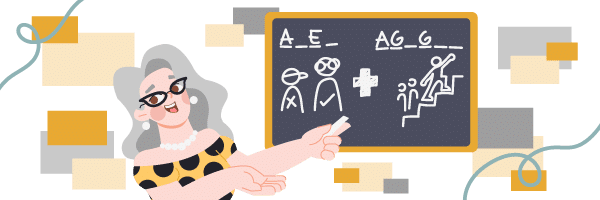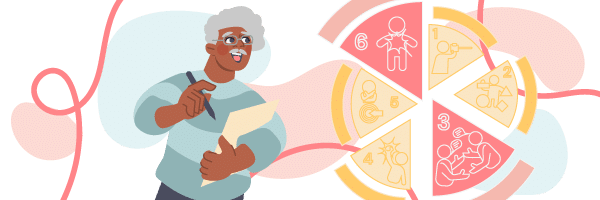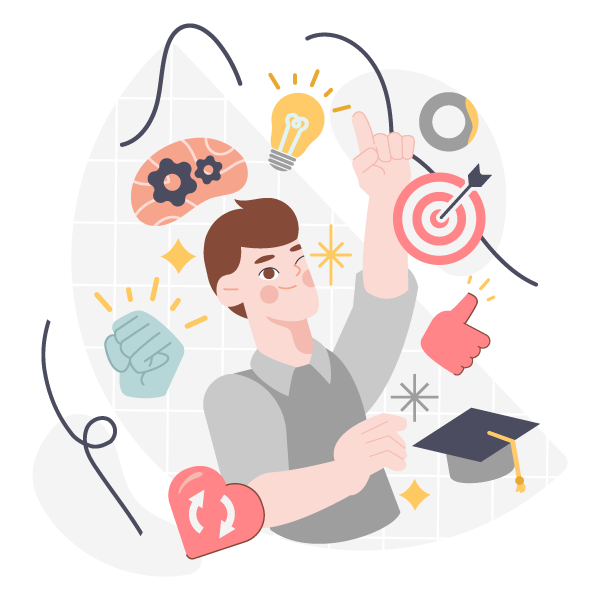Today’s hyper-competitive market requires effective customer education programs to be successful. These programs have become a cornerstone of successful business strategies and equip customers with the knowledge and skills they need to make the most of products or services.
The result? An enhanced overall experience and satisfaction. A well-implemented customer education program not only improves customer retention but also boosts loyalty and advocacy.
This article will explore the essential components of customer education, providing actionable insights to help professionals design and implement successful programs.
Understanding customer education
Customer education is a range of activities aimed at teaching customers about the features, benefits, and best practices of a product or service. It can take various forms, including tutorials, webinars, documentation, and interactive learning modules.
Remember that the core objective is to empower customers with the information they need to achieve their goals efficiently and effectively. You can also use feature voting tools to find out what customers need in detail instead of building blindly.
For business owners, instructional designers, and customer success managers, understanding the fundamentals of customer education is non-negotiable. This involves:
- Recognizing the different types of educational content that can be created
- Understanding the needs and preferences of the target audience
- Employing strategies that facilitate meaningful learning experiences
By investing in robust customer education programs, businesses can enhance customer engagement, reduce support costs, and ultimately drive better business outcomes.
The importance of customer education
Customer education is a fundamental aspect of modern business strategies. Understanding and implementing effective customer education practices can transform how businesses interact with their customers and significantly impact overall performance.

Enhancing customer engagement
Customer engagement is the emotional connection customers form with a brand, directly influencing their interaction and loyalty. Effective customer education enhances engagement by providing valuable knowledge and resources that help them understand and use products or services more effectively. Additionally, incorporating QR codes into educational materials can facilitate quick access to resources, allowing customers to engage with content seamlessly.
For instance, companies like HubSpot have built extensive educational platforms like HubSpot Academy. This initiative offers free courses on marketing, sales, and customer service, empowering users to leverage HubSpot’s tools more efficiently.
By creating customer training solutions and comprehensive learning materials, HubSpot increases user engagement and fosters a deeper connection with its audience. Customers who are well-informed about the features and benefits of a product are more likely to use it regularly and advocate for it within their networks.
Similarly, Salesforce’s Trailhead platform exemplifies successful customer education. Trailhead provides interactive, gamified learning modules that cover a wide range of topics, from basic CRM usage to advanced customization.
An engaging approach like this keeps users motivated and invested in learning, leading to higher levels of product adoption and satisfaction.
The benefits of enhanced engagement extend beyond improved usage. Engaged customers are more likely to provide valuable feedback, participate in community discussions, and contribute to brand advocacy. They become more involved with the brand, which can lead to increased customer retention and positive word-of-mouth.
Driving customer success
Educating customers plays a crucial role in ensuring they achieve desired outcomes with a product or service. When customers understand how to use a product effectively, they are more likely to experience success, which translates into higher satisfaction levels and greater loyalty.
A great example is Adobe. Adobe offers extensive educational resources through Adobe Learning, including tutorials, webinars, and community forums. By helping customers master their suite of tools, Adobe ensures that users can fully exploit the software’s capabilities. It enhances the user experience and increases the likelihood of customers renewing their subscriptions or purchasing additional products.
Atlassian, the company behind popular tools like Jira and Confluence, provides a range of educational materials, including online courses, documentation, and user communities, ensuring that customers can navigate complex project management tasks and collaborate effectively using Atlassian products. As a result, customers experience more significant success in their projects, which reinforces their commitment to the tools and the brand.
When customers achieve their goals using a product or service, they are more likely to remain loyal, provide positive testimonials, and recommend the product to others. This not only boosts customer retention but also drives new customer acquisition through referrals and positive reviews.
Reducing support costs
Effective customer education can substantially reduce the need for customer support and associated costs. By providing customers with comprehensive self-service resources, businesses can minimize the volume of support inquiries. It enables customers to find answers to common questions and resolve issues independently, reducing the demand for direct support interactions.
A well-structured educational program includes resources such as detailed FAQs, how-to guides, video tutorials, and interactive forums. These resources empower customers to address their own needs without requiring assistance from support teams. Reducing the volume of routine support requests not only lowers operational costs but also improves the efficiency of the support function. Support teams can allocate their time and resources more effectively, leading to better management of complex issues and enhanced overall service quality.
Strategies for implementing customer education programs
Implementing effective customer training programs requires a strategic approach. Key steps include identifying customer needs, developing engaging content, leveraging technology, and measuring effectiveness.

Identifying customer needs
Accurate understanding of customer needs forms the foundation of effective education programs. Companies must actively seek and analyze customer data to pinpoint knowledge gaps and areas requiring improvement.
- Conduct in-depth customer interviews: Go beyond surveys to uncover deeper insights into customer challenges and aspirations. For instance, explore specific pain points, desired outcomes, and preferred learning formats through one-on-one conversations.
- Analyze customer support interactions: Identify frequently asked questions and common issues to inform content development. For example, analyze support tickets and call logs to uncover recurring themes and knowledge gaps.
- Utilize customer segmentation: Tailor educational content to specific customer groups based on demographics, behavior, or needs. For instance, create targeted content for different customer tiers, industry verticals, or product usage levels.
- Leverage customer feedback channels: Monitor social media, review platforms, and read customer forums for insights into customer sentiment and educational needs. You can start by analyzing online discussions to identify emerging trends and questions.
Developing engaging content
Content lies at the heart of customer education. To maximize impact, create materials that are both engaging and relevant.
- Tutorials: Break down complex topics into easily digestible steps. Use clear and concise language accompanied by visuals or screen recordings to enhance understanding.
- Webinars: Offer interactive learning experiences, allowing for real-time interaction and question-and-answer sessions. Invite subject matter experts as guest speakers to provide additional value.
- FAQs: Address common customer inquiries concisely. Organize FAQs into categories for easy navigation and reference.
- Tailored content for diverse learning styles: Use visuals, text, and audio formats to cater to different preferences. Incorporate interactive elements like quizzes, simulations, and gamification to enhance engagement.
- Content calendars: Plan and schedule content creation and distribution to ensure consistency and relevance. Align content with customer lifecycle stages and marketing campaigns by leveraging generative AI in marketing to personalize and optimize messaging, and use email marketing automation to deliver that content at the right time to the right audience based on their behavior and stage in the journey.
Leveraging technology
Technology significantly enhances customer education delivery. Learning management systems, video platforms, interactive tools, mobile apps, data analytics, and artificial intelligence (AI) are all powerful tools that can be leveraged to create engaging and effective learning experiences.
- Learning management system (LMS): Streamline content organization and distribution with a robust LMS platform. An LMS offers powerful tools for tracking learner progress, delivering personalized recommendations, and facilitating knowledge assessments.
- Video platforms: Host tutorials and webinars, expanding reach. Optimize video content for search engines to increase discoverability.
- Interactive tools: Boost engagement with quizzes, simulations, and gamification. Use data analytics to track user interactions and identify areas for improvement.
- Mobile apps: Provide on-the-go access to learning materials. Offer offline access for users with limited connectivity.
- Data analytics: Track user behavior to inform content improvements. Use data to identify high-performing content, measure learner engagement, and optimize the overall learning experience.
- Artificial intelligence (AI): Explore AI-powered tools for personalized learning recommendations, content creation, and automated support. You can also learn how AI in customer service is transforming user engagement through automation and smarter interactions. AI can further be used to analyze learner data and provide insights into knowledge gaps and learning preferences.
Measuring effectiveness
Finally, effective customer education demands continuous evaluation. Key metrics include completion rates, engagement levels, knowledge retention, and behavior changes. To streamline data collection and reporting, many teams hire a virtual assistant to pull metrics, assemble dashboards, and distribute insights to stakeholders. Analyze data to identify successful initiatives and areas for improvement.
- Customer surveys: Measure program impact on satisfaction and loyalty. Conduct pre- and post-education surveys to assess knowledge gain and behavior changes.
- Use insights: Refine content, delivery methods, and overall strategy. Set clear objectives for each education program and track progress towards these goals.
- Calculate return on investment (ROI): Measure the financial impact of customer education programs by tracking revenue growth, cost savings, and customer lifetime value.
Best practices for customer education
Customer education isn’t just about creating content and distributing it. Effective programs go beyond merely informing customers, they focus on continuous improvement and adapting to industry changes. Success in customer education hinges on several advanced practices that ensure the program remains impactful and relevant.
Align educational content with customer goals and product objectives
Understanding what customers aim to achieve with a product helps tailor educational materials to meet those specific needs. Content should be designed to address the most common use cases and challenges faced by customers. A focus on practical, actionable information enhances the relevance of the education provided.
Make regular updates to educational materials
As products and services evolve, so should the educational resources. Continuous review and revision of content ensure that it remains accurate and relevant. Implement a systematic approach to content updates, incorporating feedback from users and monitoring changes in product features or industry standards.
Engage in ongoing assessment of educational effectiveness
Utilize performance metrics and customer feedback to evaluate how well the content meets its objectives. Analyze data on user engagement, completion rates, and support inquiries to identify areas for improvement. Regularly review these metrics to adapt strategies and enhance the educational program.
Incorporate diverse content formats to cater to different learning preferences
Combining written guides, video tutorials, interactive simulations, and live webinars addresses various learning styles and keeps the content engaging. Offering multiple formats also accommodates different levels of expertise, from beginners to advanced users.
Maintain a strong focus on user experience
Ensure that educational materials are easily accessible and user-friendly. Organize content in a logical structure, with clear navigation and search functionalities. A well-designed user interface facilitates easier access to information and improves overall learning efficiency.
Stay updated with industry trends and technological advancements
The landscape of customer education is continually evolving, with new tools and methods emerging. Staying updated with industry trends and emerging technologies ensures program relevance and engagement. Keep abreast of the latest developments to incorporate innovative approaches into educational programs. Adapting to new trends can provide additional value to customers and enhance the overall effectiveness of the education provided.
Foster a culture of continuous improvement within the organization
Encourage feedback from both customers and internal stakeholders to identify opportunities for enhancement. Implement a feedback loop that allows for regular updates based on insights and changing needs. This proactive approach helps maintain the relevance and impact of educational initiatives over time.

Enhancing customer relationships with education
Customer education is a cornerstone of building strong and lasting customer relationships. By empowering customers with the knowledge and tools to succeed, businesses foster loyalty, advocacy, and long-term value.
To create truly impactful education programs, a deep understanding of customer needs is essential. Leveraging technology, such as a robust learning management system, and learning experience designers like those at ELM, can enhance the delivery and personalization of educational content.
With continuous evaluation and improvement, organizations can optimize their education initiatives to drive business growth and customer success.
Contact us today to learn how ELM can help you train your customers to get the most out of your products.






